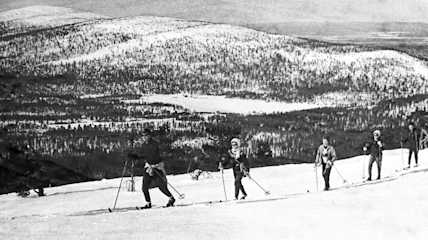
Passion, infrastucture and innovation
Finland is full of beautiful landscapes and interesting tourist destinations. But some destinations are evolving to become more attractive than others. In Finland, one turning point occurred at the turn of the millennium when Levi emerged as the most visited ski resort in Finland. Many things had changed since its modest beginnings.
In the 18th century, Levi fell was occasionally marvelled at by researchers and cartographers; in the 19th century, it attracted adventurous hikers; and in the early 20th century, it drew pioneering enthusiasts of fell skiing. In the latter half of the last century, Levi transformed into an internationally renowned destination. The decisive factors were largely the same as in the early 1900s: improvements in transportation, a passion for service development, and pioneering innovations.
The increasing prevalence of car traffic and improvements in roads made Sirkka increasingly accessible. Public transportation grew, tourism services expanded and evolved, with cabins, inns, and eventually hotels cropping up in the village of Sirkka. However, besides nature, entertainment was also needed. The first drag lift began pulling skiers up the fell in 1964, initiating a series of investments that accelerated with each passing decade.

Skiers at Levi in the 1980s. Torsti Kinnula, Collection of the Finnish Tourist Board, Finnish Heritage Agency.
The 1980s provided an exceptionally unique opportunity for Levi fell with the opening of Kittilä Airport for civilian traffic. In practical terms, there was nowhere else in the world with an airport just a fifteen-minute drive from the slopes of a ski resort. This became a threshold for Levi's true internationalization.
A crucial phase occurred in the early 1990s when the visionaries of Kittilä, led by the newly appointed CEO Jouni Palosaari, began implementing a ski slope network throughout the entire Levi fell. Investments were expedited by the recession. The equipment from several small ski resorts quickly moved to Levi, where the recession was turned into an opportunity. Levi was chosen as Finland's Ski Resort of the Year for the first time in 1993, followed immediately by 1994. This was just the beginning.

Slope map after the investments during the recession in 1996. Levi Ski Resort archive.
The next level of visions was beyond the Finnish market, reaching out internationally. The dream of hosting an alpine skiing World Cup in a country without mountains began to take shape. The dream was considered utopian for several reasons. Levi was supposedly distant, dark, and too cold. However, the determination of the people of Levi was stronger.
On the western slopes, a suitably challenging area was found for a slalom slope meeting the criteria for a World Cup event. Lighting was installed that far exceeded the requirements of TV production. And eventually, the fact that the slopes and the resort were only a fifteen-minute drive from the airport began to turn even the most rigid international decision-makers' heads towards the cool north. And ultimately, decades have shown that even the coldness was a strength.


Documents related to the planning of Levi Black slope. Levi Ski Resort archive.
As the cherry on top, in order to serve the World Cup slope, Levi decided to build Finland's first gondola lift. Admittedly, a gondola might not have been the most efficient way to transport skiers to the top of the fell in Finnish conditions, but unquestionably, it was the most international way. Alongside the lift, the gondola was a story – a phenomenon that emphasized Levi's transition from a national level of development to an international one.


Gondoli2000. Levi Ski Resort archive.
Tanja Poutiainen frequently ascended the podium at Levi. Levi Ski Resort archive.
The turn of the millennium saw several celebratory moments as Kalle Palander won the slalom World Championship gold, the Levi Black slope was completed, and the gondola lift was launched. This allowed for showcasing Levi's competitive capabilities with well-organized Europa Cup races. The inevitable consequence was the Alpine Ski World Cup in 2004. Finland's rise on the international Alpine skiing scene was aptly emphasized by Tanja Poutiainen's victory in the opening race. The television broadcasts of the Alpine skiing competitions reached millions of viewers, serving as a massive tourism advertisement that manifested in the growth of traffic at Kittilä Airport.
However, it's crucial to remain on the world stage. Development at Levi has continued vigorously both in the village and on the fell. Although the annual World Cup is a prominent jewel in the crown, the majority of investments are directed towards serving and transporting ordinary tourists. Few businesses can claim to have invested over 100 million euros in moving people within just a few decades.
The Levi Glacier project extends the skiing season on the front slopes. Levi Ski Resort archive.

Levi's front slope 60 years ago and now. Levi Ski Resort archive.
Kalle Rantala
Exhibition Manager
TAHTO
The Ultimate Levi Exhibition on display at TAHTO, Helsinki Olympic Stadium, January 25th to April 7th, 2024.




